- Like
- SHARE
- Digg
- Del
- Tumblr
- VKontakte
- Flattr
- Buffer
- Love This
- Save
- Odnoklassniki
- Meneame
- Blogger
- Amazon
- Yahoo Mail
- Gmail
- AOL
- Newsvine
- HackerNews
- Evernote
- MySpace
- Mail.ru
- Viadeo
- Line
- Comments
- Yummly
- SMS
- Viber
- Telegram
- JOIN
- Skype
- Facebook Messenger
- Kakao
- LiveJournal
- Yammer
- Edgar
- Fintel
- Mix
- Instapaper
- Copy Link
 Why Every Day Shouldn’t Be PR Day
Why Every Day Shouldn’t Be PR Day
For many athletes that are looking for new and challenging ways to push their limits, whether it’s through a Crossfit box, personal trainer, or your newly Black Friday purchased home gym – the thing that always happens is that once we get into a routine, all we want to do is hit that next personal record (PR).
We tend to focus on a light warm-up, consult our last workout and immediately try to best it – sometimes even within the same week; week in, week out. This is a bad idea. It is not reasonable to push your limits without a proper program that allows for build-in corrective exercises, periodization, and re-evaluation before you make that next impressive push.
Without some guidance, you increase exponentially your risk for injury and – of course you won’t hit that PR.
I’m going to focus here on the ‘new’ workout technology that we call Olympic Lifting. Now, I hate to break the news, but Olympic weightlifting is anything but new, so if it’s new to you pay attention.
It’s origins date back to the Olympics in 1896, and has been a regular event in the Olympiad since 1920. The original lifts were: the press (eliminated since 1972), the snatch, and the clean & jerk.
Remember people, Olympic Lifting is it’s OWN SPORT – it takes years to become proficient, to develop consistent technique and most of all, it cannot be perfected over a weekend seminar.
So why is it then that many people are obsessed with maxing out each and every session they lift?
Now, I’m not picking on Crossfitters here, I am pointing out bad form. Why are these people sacrificing form and common sense to ‘hit that rep’? I can’t say, but I can bet they didn’t feel great the following morning. Not only will it lead to overtraining, but also fatigue and eventual injury.
Logic would suggest: “If you can’t hit the weight for your snatch or clean & jerk, then do more snatch and clean & jerks!”
While there are truths to this – and yes, you need to practice these lifts to become more proficient, long term longevity and injury reduction require a better strategy.
Get an Olympic Weightlifting Coach
Remember, you don’t know what you don’t know. Getting someone who has a background (years, not a weekend course) in lifting, someone who has attended workshops – even led them is where you should start. They will make assessments and find out where you first need to begin before you can begin throwing weight around.
Further Reading:
Your 1-rep max (1RM)
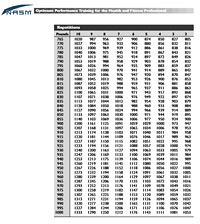 In order to find out where you need to safely begin your progressions from, you need to determine your 1RM in the Squat, Pulling, and Overhead movement. USA Weightlifting identifies these three movements as ‘Power Assistance Exercises’.
In order to find out where you need to safely begin your progressions from, you need to determine your 1RM in the Squat, Pulling, and Overhead movement. USA Weightlifting identifies these three movements as ‘Power Assistance Exercises’.
By following an algorithm (Check out the NASM 1RM chart), you can see how you can train into increasing your weight by the amount of repetitions you can safely perform. Further, these exercises are breakout patterns that are found within the Snatch and Clean & Jerk and can be integrated into a training program where you can add heavier weight (safely) throughout your training.
These movements allow you to gain strength, coordination and stability – all of which will directly correlate to improved performance in your lifts.
Still not convinced?
- You cannot snatch anything if you cannot get it off the ground – welcome to Pulling
- You cannot complete the lift if you can’t stand up – welcome to Squatting
- You cannot complete the lift if you can’t get it up overhead – welcome to Overhead
Now that you have your coach and your numbers, and a training program backing you, let’s talk about the five key movements you need to master in order to perfectly execute those Olympic Lifts.
5 Key Movements to Master Before You Can Perfectly Execute Olympic Lifts
#1. SQUATTING
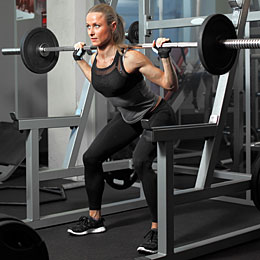 This is your base for pretty much everything else. It develops Strength. You want to focus primarily on the Front, Back, Single Leg and Pause Squat.
This is your base for pretty much everything else. It develops Strength. You want to focus primarily on the Front, Back, Single Leg and Pause Squat.
Front & Back Squat – both of these movements represents segments of the Clean lift. Further, they maintain an upright torso, which helps with maintaining center of gravity and keeping the weight in a safe position. Lastly, you should be able to Back Squat more than Front Squat, so if you are lacking here, you need to address some mechanical issues such as lack of hip or ankle mobility.
Single Leg & Pause Squat – if the athlete lacks stability; or asymmetry is noted during unilateral leg exercises, than it must be addressed to prevent injury. Pause Squats are phenomenal because they provide you with the strength needed to sit at the bottom of a Clean or Snatch before standing up.
Frequency – Elite lifters are often perfecting the squat 4-5 times a week. Now, before you have a freak-out, consider that these lifting days are progressions and utilize a combination of the various aforementioned lifts. You may not be working exclusively on the front squat, it may only be part of your routine on that day, mixed with other upper body strengthening routines.
Sample Assistance Exercises:
- Back Squat
- Front Squat
- Pause Squat
- Single-Leg Squat
- Overhead Squat
#2. PULLING
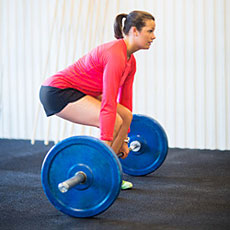 This movement helps to develop your power and speed. The movement of pulling is from the ground, past your knees and hips until you get it up high enough in order to get under it.
This movement helps to develop your power and speed. The movement of pulling is from the ground, past your knees and hips until you get it up high enough in order to get under it.
The pulling movement is segmented into the first pull (ground to power position) and the second pull (power position to transitioning under the bar).
First Pull – here, you need to practice the lift from the ground, past the knees and into the power position with the pop of your hips to extend through the shoulders. Most experts recognize pulls can be done with heavier loads, typically 105 – 110% of your target weight. In this way, you are training your body by picking the bar off the ground with speed and transitioning into the power position. Of course, you will always begin at a lower weight to ‘grease the wheels’ and safely train to your max.
Side note: deadlifting or Romanian deadlifts are good as they are great strength builders. But here, we are talking about developing power and speed; which is where the Pull movement becomes highly effective.
Second Pull – here, you go from the power position to the highest point at which you can transition under the bar. Training using High Pulls, Scarecrows, or going through Triple Extensions are also helpful for getting quick with getting the weight up and making it feel effortless. These movements also help you to train by keeping the bar close to your chest – the further you are from the bar, the more energy you are wasting on the pull, which can affect your results and the amount of weight you can lift.
Frequency – as mentioned previously, many train 4-5 times a week for many of these movements. The benefit of these three Power Assistance Exercises (Squat, Pulling, Overhead) are that they can be done as parts of the rest of your workout.
Sample Assistance Exercises:
- Deadlift
- Romanian Deadlift
- Snatch High Pull
- Clean High Pull
- Snatch Grip Deadlift
#3. OVERHEAD
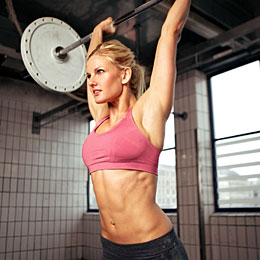 This movement helps to develop overhead strength. Exercises you want to focus on are the Strict Press, Push Press, Power Jerk, Spit Jerk and Overhead (which also encompasses the Squat which we talked about earlier).
This movement helps to develop overhead strength. Exercises you want to focus on are the Strict Press, Push Press, Power Jerk, Spit Jerk and Overhead (which also encompasses the Squat which we talked about earlier).
It is always best to perform these movements while standing as to mimic the actual Olympic lift. Using benches or machines may provide initial stability until the move is learned or until heavier weights are being used, but they are isolated movements.
Arm Lock Out – this is a huge component of any overhead lift and must be emphasized. Think of proper lockout as you forming an inverted triangle with the bar, your arms and your neck. Proper lock our occurs behind your head / back.
Mobility / Positioning – often, athletes are strong enough to lift a weight overhead, but have problems keeping it there. This may be a mobility problem in which they lack adequate flexibility to achieve lockout. Once this is cleared out, proper hand positioning on the bar is vital. A grip that is too wide or too close will force the athlete to compensate and possibly incur injury as they strive to achieve lockout.
Sample Assistance Exercises:
- Strict Press
- Push Press
- Power Jerk
- Split Jerk
- Snatch Press
The Bottom Line
- Take Olympic weightlifting seriously. You can incur serious harm in your knees, low back and shoulders.
- Get an Olympic weightlifting coach – they are the most knowledgeable resource you will ever have.
- Find your 1RM and build a baseline, then design a program.
- Utilize the Assistance Exercises (Squatting, Pulling, Overhead) in order to break down your overall Olympic Lifting into segments before putting it all back together.
References:
1. Baechle, T.R. & Earle, R.W. (2008). Essentials of Strength Training and Conditioning (3rd. Ed.). Champaign, IL: Human Kinetics.
2. Camargo, D. Building Strength for Olympic Weightlifting. Retrieved online from: http://www.boxlifemagazine.com/training/building-strength-for-olympic-weightlifting
3. Starrett, K. & Cordoza, G. (2013). Becoming a Supple Leopard. Las Vegas, NV: Victory Belt Publishing Inc.
4. United States Olympic Committee. What is the sport of weightlifting. Retrieved online from: http://www.teamusa.org/USA-Weightlifting/Weightlifting101/The-Lifts
About Erik Uuksulainen
True North Chiropractic Erik Uuksulainen is a board certified doctor of chiropractic who specializes in working with athletes, both at the recreational as well as collegiate level. Dr. Erik holds a MS in Clinical Nutrition (2010). In 2004, he graduated from the University of Guelph, Canada, with a BSc in Human Kinesiology.

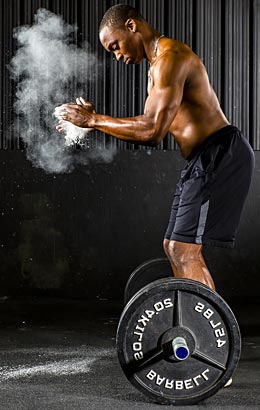 Why Every Day Shouldn’t Be PR Day
Why Every Day Shouldn’t Be PR Day